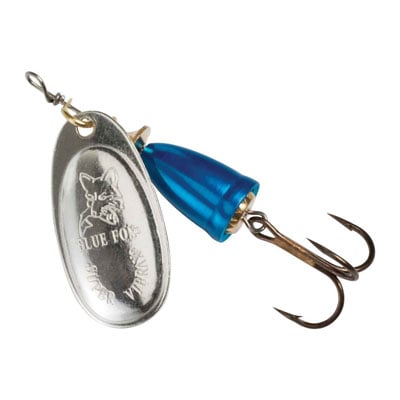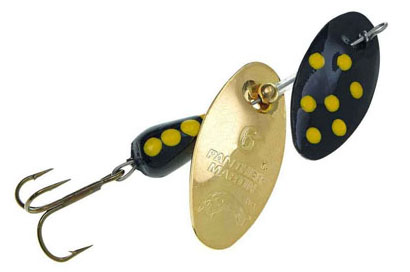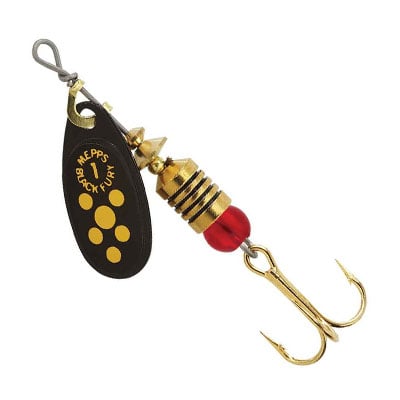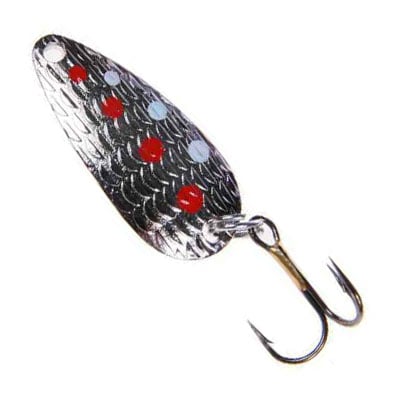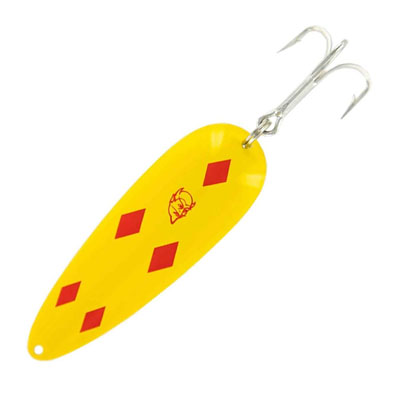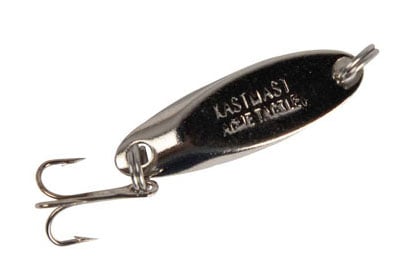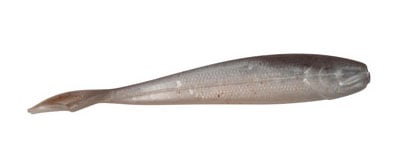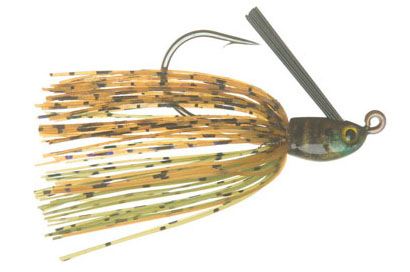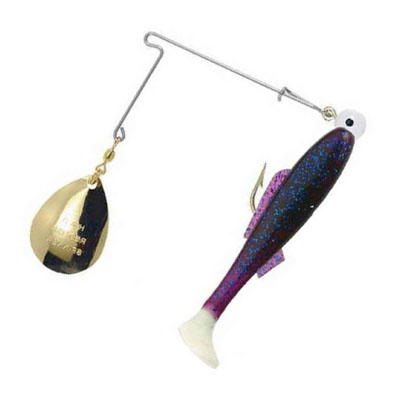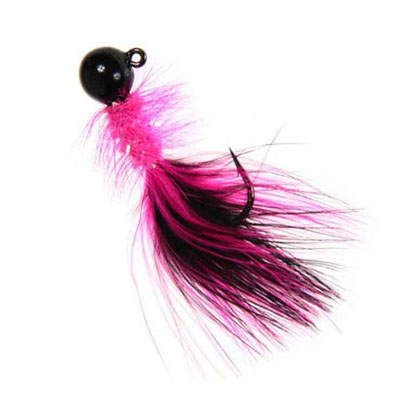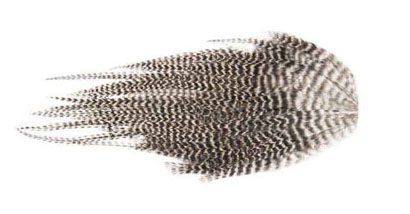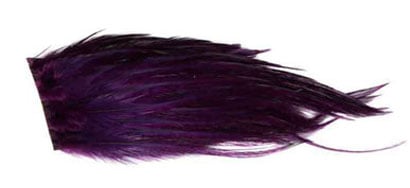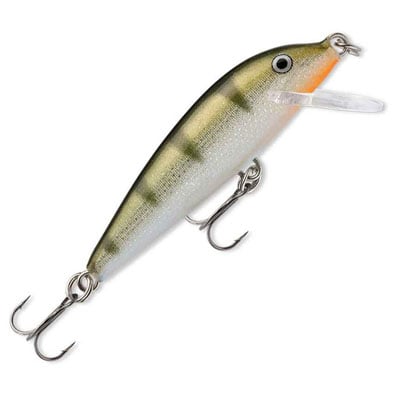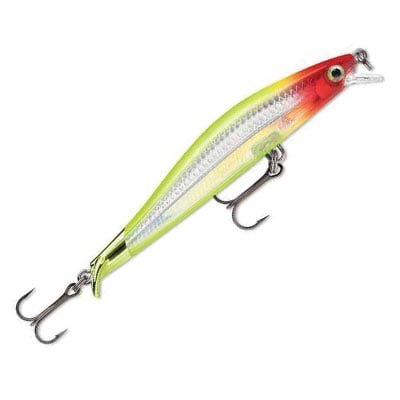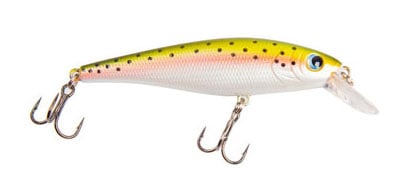Best Trout Lures
for Any Season
By Randy Tucker |
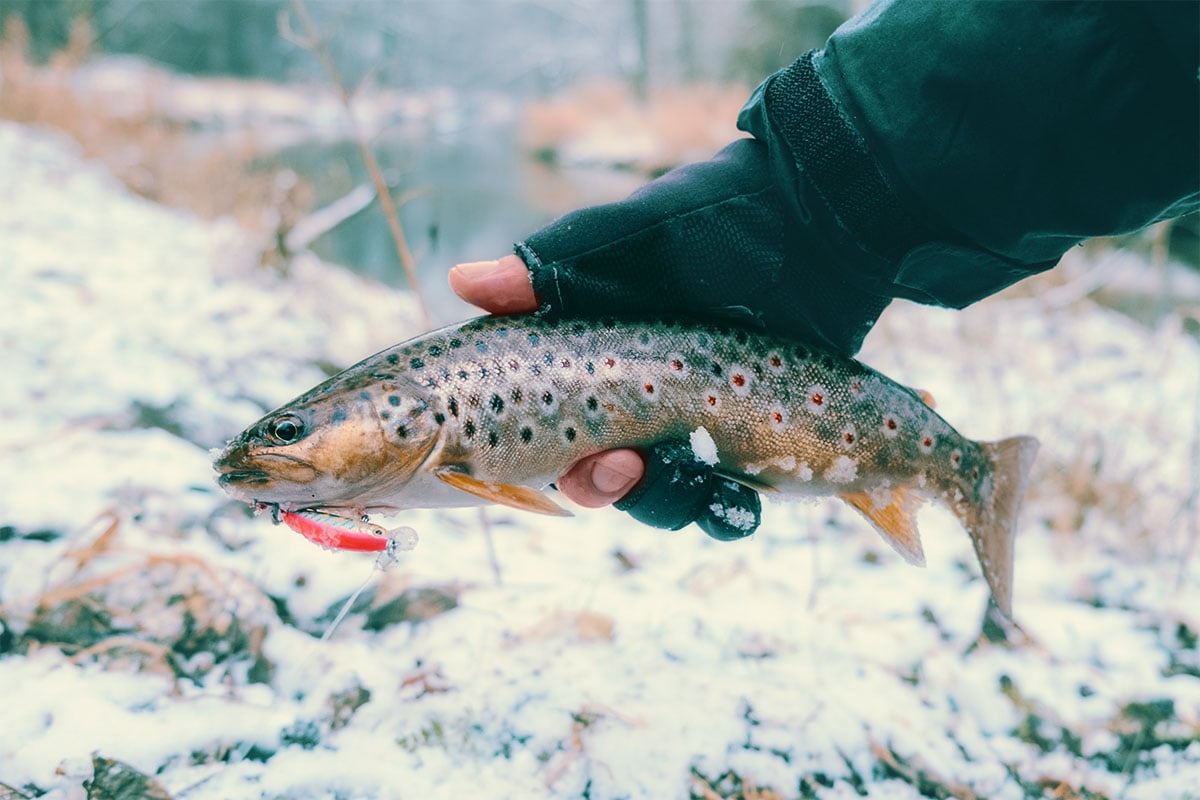
Trout, those darting freshwater missiles, are the stuff of anglers’ dreams. Having the right lure is a key part of bringing in this fish.
Trout can be caught all year long, in streams, rivers, beaver ponds, and in massive reservoirs. Rainbow, brook, brown, cutthroat, and mackinaw are all fair game through the four seasons for industrious anglers, but the same lure won’t work in every setting.
Spinners, jigs, woolly buggers, spoons, and jerk baits can all generate strikes from any of the five species, but no single lure will work in all conditions with all species. The habits and habitat of trout vary almost as much as the seasonal weather conditions that affect their feeding styles. You might catch a rainbow trout through the thick ice of January on the same jig that works in the heat of July, but the odds are against you. We’ll break down the lures that work the best for each type of trout and help you adapt them to the changing times of the year.
Top Trout Lures:
Comparison Chart - Trout Lures for any Season
| Species | Spring | Summer | Fall | Winter |
|---|---|---|---|---|
| Rainbow | Spinners, spoons, jigs, woolly buggers | Spinners, spoons, jerk bait | Woolly buggers, spinners, spoons | Woolly buggers, jigs, jerk baits |
| Brook | Spinners, small jigs, smaller woolly buggers | Spinners, jigs | Woolly buggers, spinners | Jigs, woolly buggers |
| Cutthroat | Spinners, woolly buggers, jigs | Spinners, spoons, woolly buggers, jerk baits | Woolly buggers, jerk baits, spinners | Jigs, woolly buggers |
| Brown | Woolly buggers, jerk baits, jigs | Spoons, spinners, woolly buggers, jerk baits | Jerk baits, woolly buggers | Jerk baits, woolly buggers |
| Mackinaw | Jerk baits, spoons, spinners, jigs | Spinners, spoons, jerk baits | Jerk baits, woolly buggers, jigs | Jigs, jerk baits, woolly buggers |
1. Spinners
Many spinning and spin cast trout anglers consider the spinner the best lure to use in a wide variety of settings. A spinner gets its name from the whirling blades that spin in the water as the lure is retrieved. They come in many sizes, from tiny #1 spinners weighing just a fraction of an ounce to massive #6 or larger spinners that can be several inches long. Spinners catch the light and mimic the movement of baitfish. They can also create sonic vibrations in the water that will attract trout on cloudy darks or in murky water.
Rainbow trout love spinners. These aggressive predators hit lures hard and run deep or tail dance in a ballet of battle. It doesn’t get much better on the water than when a big rainbow hits a spinner.
Cutthroat and brook trout will hit hard as well, but don’t dance like rainbows. You’ll get milder strikes, followed by deep dives from mackinaw. Browns don’t hit as hard, preferring to mouth the lure, but once the hook is set they’ll dive deep, use the current in their favor or try to wrap your line around submerged structure.
Types of Spinners:
- Blue Fox
- Panther Martin
- Mepps
Blue Fox Vibrax
A relatively new arrival to the spinner world, the Blue Fox Vibrax has caught the angling world by storm with high-quality, high function spinning lures offered in a wide variety of sizes and color schemes. The blade action on a Blue Fox is unsurpassed. They spin freely in still water on slow retrieves and work equally well at depth or on the surface. Available in silver, gold, or colored blades with similar bodies, these lures are best for trout in the #3 and #4 sizes where they work well in attracting larger, more aggressive rainbows and mackinaws.
Panther Martin
Advertised as a “sonic spinner” the legendary Panther Martin pulls a little harder in the water on retrieves than competing spinners. The blade design creates ripples that make a lot of underwater noise.
Mepps
The tried and true spinner, one of the first offered on a nationwide scale back in the 1950s and 60s, and still a viable contender today. A Mepps style spinner has all the grace and elegance of a battle tank.
These lures are strong, durable, and designed to hook trout on the first strike. They were originally only offered in bronze but are now offered in a rainbow of colors. Mepps took notice of rival Roostertail spinners and has some models with tails covering the treble hook that work well with brown trout on slow retrieves. Mepps don’t get the press that Blue Fox does, and they’re not advertised as well as Panther Martin but they are effective.
2. Spoons
Types of Spoons
- Thomas Cyclone
- Five of Diamonds
- Solid Color
Thomas Cyclone
One of the first spoons to hit a nationwide fan base, the venerable Thomas Cyclone remains one of the best. This spoon comes in bronze, silver, and various colors with a hammered metal finish that resembles fish scales. The strategic red pattern of dots creates a lure that will even fool you on occasion when you reel it in. It looks amazingly like a small trout swimming through the water.
Five of Diamonds
This one is a personal favorite. It is my go-to spoon when nothing else is working. The Five of Diamonds came in solid black, red, or white in its original release with contrasting red, white, or black diamonds arranged just like the playing card. When trolled, the lure spins, creating the optical illusion of a large baitfish in three dimensions. This is a great trolling lure, but whether you cast it from shore or troll it behind your boat a snap-swivel is a great idea to keep the lure moving as it was meant to in the water without twisting your line.
Solid Color Spoon
This is the most generic of spoons, made by international fishing corporations, and in garages across the country. The venerable spoon is made of heavy gauge bronze or chrome-colored metal. All you have to do is hammer it into the shape you want on an anvil or add a few dimples with a hammer and round point chisel, and you have a trout-catching machine. Drill a hole at the tip for your snap swivel to attach and another at the end for a treble hook and you’re in business. These work for all species of trout, with the smallest ones attracting brook, cutthroat, and small rainbow trout, and the larger ones generating strikes from big rainbows, browns, and mackinaw. They work well year-round in bright light and can be cast, trolled, or even jigged through the ice.
3. Jigs
The oldest of all lures, descending from the gorge of ancient fishermen, the jig is still one of the best overall lures and is the top lure when it comes to ice fishing. A jig is a simple hook with a bit of lead attached at the eye. Jigs can vary in size from tiny fractions of an ounce to large #00 or larger hooks with heavy chunks of lead attached.
A jig is useless without something attached to attract trout and cover the hook. Many jigs have round heads with colored “eyes” that resemble fish heads. They can also be shaped like the front end of a baitfish with a head and body above the gills. These lures work with rubber minnows in standard colors or even wilder patterns of neon orange, chartreuse, and green. Some anglers prefer skirted jigs covered with coarse deer hair. They work best when cast and retrieved in an up-and-down, jerking fashion, or with the drop shot rigs above weed beds. Through the ice, they’re deadly on mackinaw, browns, and rainbows.
Types of Jigs:
- Lead head with Gulp minnow
- Skirted jig
- Spinner jig
Lead Head with Gulp Minnow
A standard #6 to #2, long-shanked hook with a round lead head attached at the eye is a great lure to throw in lakes all year round. This is one lure that will work all 12 months of the year when presented properly.
A black and silver gulp minnow is the closest thing you’ll find to a live shiner minnow, and trout can’t tell the difference either. Dropping and retrieving this jig will get hits from walleye, perch, and crappie too, but it will get the rainbows and mackinaws coming in hard for a taste. Throw them in the spring adjacent to runoff feeding reservoirs, or later in the summer on a boat above suspended trout in deeper, colder water. On the ice, they work well with an arrangement of minnows and nightcrawlers near your ice hole while you jig. The magic of these jigs is that even in the dark you’ll get actions.
Skirted Jig
These jigs can be identical to round-head lead jigs in design with a skirt of coarse deer hair covering the hook. The skirt can be a solid grey, brown, or white, or it can be stained in a variety of bright colors. The magic is that the deer hair catches air bubbles and fluffs out, mimicking baitfish in the process. A skirted jig can be poured in the shake of a baitfish as well, with the same skirting behind the shaped head and upper body.
These work better in open water than through the ice since the head is more natural in appearance, and few baitfish will swim vertically toward a layer of ice. In open water on a moderate retrieve, they work in the water like panicked baitfish. Rainbows, mackinaws, and an occasional brown will move toward shore in pursuit of shallow-water baitfish and hit these skirted jigs.
Spinner Jig
The addition of a blade spinner behind the lead head of the jig adds another dimension to jig fishing and can offer jigging as a viable trolling option. The spinner is a single blade, usually, silver that catches light, creates an additional sonic vibration, and works with the jigging action of an attached rubber minnow to hit trout with a double whammy.
A warning on this lure is to not get too dependent on the blade action alone as you would with a standard spinner. You still have to jig the lure to get the maximum effect, but on bright sunny days when the light is playing off the water, this is a great option, even in fast-moving streams and rivers. This is one jig that will work with all five species of trout. Use a smaller jig, and a faster retrieve cross current or against the flow of the water for cutthroat, brook, and small rainbows or a standard jigging pattern from shore.
4. Woolly Buggers
What’s in a name? The woolly bugger is the most fun to say when speaking of trout fishing, but it serves a great purpose aside from being a conversation starter. Similar to a streamer, a woolly bugger bridges the world of lure and flies in fishing for trout. Though we won’t elaborate on it here, flies are a favorite method of catching trout for many anglers. A woolly bugger resembles a fly in some ways but looks much more like a bumble bee when you first take a look at them. Many anglers tie their own woolly buggers, but you can purchase them as well.
Weighted woolly buggers are deep water lures, meaning they will generate strikes below the surface of water where spoons, spinners, and jigs can be ineffective. Spinning rod woolly buggers will get action similar to a fly rod when presented correctly. These lures are made to drift with the current and should be guided towards cutbanks, backflows, and on the back side of boulders in fast-moving streams. These are good for brook trout, rainbows, and cutthroats. Don’t use them in typical mackinaw settings and they won’t work as well with browns either.
Types of Woolly Buggers:
- Woolly Bugger Jig
- Ewing Grizzly Bugger Patch – Tie your own
- Whiting Farms Woolly Bugger
Woolly Bugger Jig
A colorful woolly bugger, matched to the water conditions can bring trout when nothing else works. These woolly buggers were originally introduced for salmon fishing, but quickly caught on with steelhead and rainbow trout anglers as well.
The tight design with colorful plumage creates a strong image in the water, and when properly presented is a lure that will draw attention. Once at depth, work the lure with slight jerks and a steady retrieve in cross currents, or simply let it dip with minimal tension. When a rainbow, cutthroat, or brown hits, they’ll often gulp the woolly bugger, setting the hook deep. These work well in summer months but can be amazing on winter rivers and streams when the air temperature is well below zero.
Ewing Grizzly Bugger Patch – Tie Your Own
Similar to the saddle hatch, except the unique patterns on the pheasant hackle are left in place with just a slight coloring dye, the grizzly bugger patch shares the same characteristics as the solid color grizzly saddle. It works best when tied to a size six or smaller hook with a light lead head. Tied correctly this pattern has good results in getting reluctant, deep-dwelling trout to hit at lower depths in river channels. This is where the big boys of the trout world often lay. The grizzly bugger patch is also a year-round option for trout.
Whiting Farms Woolly Bugger
Made of feathers instead of hackle, the Whiting Farms woolly bugger features a tapered design. This allows the lure to flow easier in the water, with more control. It doesn’t fluff as well in the water as the other two woolly buggers mentioned here, but still gets a trout’s attention with an action that mimics swimming baitfish. This tapered design works with brook trout as well as rainbows and cutthroats and is another year-round trout fishing option.
5. Jerk Baits
The old joke defines fishing as a jerk on one end waiting for a jerk on the other. The term jerk bait has nothing to do with personality and everything to do with how a lure can be presented to fish that so closely resembles the real thing that they’ll hit it as if it were a baitfish. A jerk bait is made to cast and retrieve from shore, or to troll slowly behind a boat. A fish finder is a great addition to jerk baits when trolling since you can locate the prey and the depth they’re suspended in.
The most popular jerk baits are made by Rapala, though there are many other manufacturers that resemble Rapala and can have good results. Jerk baits work for aggressive trout. They’re like candy to hunting rainbows and will get strikes from cutthroats in shallower water or from mackinaws when trolled deep and slow. These lures are covered in treble hooks, with large ones sometimes having arrays of four or more sets of treble hooks. When a fish strikes, they’re likely to get hooked. The length of the bill determines how deep a jerk bait will dive on a retrieve or troll.
Types of Jerk Baits
- Traditional Rapala
- Rapala Ripstop
- Trout magnet
Traditional Rapala
This lure has caught more mackinaw than any other. Devised for northern pike, muskie, and walleye, they quickly gained a following with lake trout fishermen. The traditional Rapala can be as small as three inches, and as large as 15 or more inches. Larger lures don’t always mean larger trout, since a hungry rainbow, cutthroat, or brookie will hit small Rapalas with a vengeance. These lures work year-round in warmer lakes that don’t freeze.
Rapala RipStop
A streamlined, double-lipped design, this is a unique lure that presents a quick side-to-side action in the water with a minimally fast retrieve. Even in slow-moving or still water, the lure does its magic with a slight tipping of your rod on each crank of the reel. The design works well with mackinaw, browns, and rainbows and is equally attractive to large and smallmouth bass. If you’re fishing in a lake with multiple species the fun of catching a little bit of everything is available with the RipStop.
Trout Magnet
As the name implies, this lure is designed for bait fish hungry trout. Don’t worry about the hatch, surface feeding, or other factors that might get strikes from surface feeding brook and cutthroat trout. This lure is designed to attract larger, carnivorous trout, apex predators if you will, such as big rainbows, browns, and mackinaws. With color patterns matching immature, fingerling-sized trout, the Trout Magnet is a great choice to keep in your tackle box on those days you’re after a wall-mounting trophy.
Conclusion
There are a lot of ways to catch trout. Some work better during one season than in another, and a handful will work most of the year, but none of them are the best in all 12 months of the year. The feeding habits of trout differ greatly by species as well. Finding the right lure for the trout you’re after is all part of the fun.
Using the information presented here we hope we’ve helped you determine which lure for which condition and which trout will work best for you.
